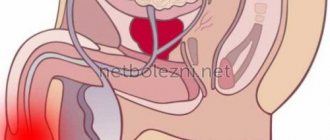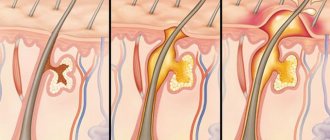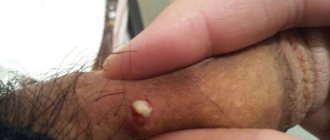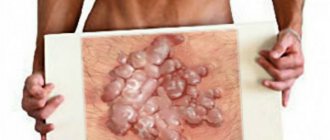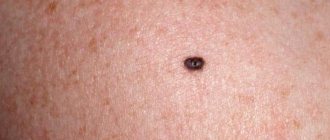Fordyce granules
Fordyce granules are hyperplastic sebaceous glands that tend to form in those areas of the body where the skin is thinnest and most delicate. Most often they are localized on the mucous membranes of the oral cavity (in particular on the cheeks), on the lips, in the groin, directly on the genitals and on the nipples. Such changes in the sebaceous glands were first described by the American dermatologist and syphilidologist John Addison Fordyce back in 1896. Hence the name that has now become generally accepted for them - Fordyce granules. Formations are considered one of the variants of the physiological norm, since they are: completely benign; do not harm health; are not accompanied by unpleasant symptoms; are not transmitted during sexual contact or any other way. That is why patients turn to specialized medical institutions only in cases where visible sebaceous glands represent a serious cosmetic defect and become a reason for a person’s dissatisfaction with their appearance. The exact reasons that provoke changes in the sebaceous glands have not been identified at the moment. However, most doctors, based on the results of pathomorphological studies of tissues, believe that the prerequisite for the occurrence of cysts are various types of congenital disorders of the development of the sebaceous glands, leading to their displacement into the upper layer of the skin or to a change in their normal location (the location of the sebaceous glands in the area of the border of the lips is considered abnormal , on the mucous membranes of the oral cavity, etc.). Another cause of Fordyce granules is considered to be hyperplasia of the excretory ducts of the sebaceous glands, which provokes the appearance of cystic formations in them. Simply put, Fordyce granules develop in people who have excessive narrowing or blockage of the excretory ducts of the glands, accompanied by the accumulation of secretions (sebum) in them. Sebaceous gland cysts first appear in humans during adolescence, when the process of puberty begins, that is, approximately in the range from 13 to 17 years. Thus, it can be assumed that the process of formation of Fordyce granules proceeds in accordance with the following algorithm: during the period of intrauterine development in the fetus, for one reason or another, the formation of the sebaceous glands is disrupted; when the child reaches a certain age, under the influence of steroid hormones that are produced by the sex glands (the so-called androgen hormones), the glands begin to increase in size and actively produce sebum, which results in their visualization.
Characteristic features of Fordyce granules. Externally, sebaceous gland cysts resemble small nodules (or papules) the size of a millet grain. As a rule, such rashes are numerous, widespread and not accompanied by pain (either at rest or when pressing on them). When pressing on the formation, in some cases a very small amount of liquid may be released from it, having a white-yellow tint and a rather thick consistency. However, more often than not, attempts to squeeze the contents out of Fordyce granules end in pinpoint bleeding and the development of hematomas in the area of skin surrounding the damaged papule.
Doctors are categorical in their prohibitions on self-removal of Fordyce granules, since this, firstly, is very painful, and secondly, provokes inflammatory processes and scarring of the skin. This is especially true in cases where the cysts are localized in the lip border area. Fordyce granules on the lips in the vast majority of cases (up to 90%) occur in women. This type of Fordyce granules occurs as a result of damage to the apocrine sweat glands, which are somewhat associated with the genitourinary system.
Treatment of Fordyce granules. Unfortunately, there are currently no effective methods for treating Fordyce granules. The use of jojoba oil and vitamin A is recommended as a means to inhibit further development of the process. These products help remove Fordyce granules that are already present and prevent the formation of new ones. Such drugs can act mainly on fresh cysts.
The main methods of removal are electrocoagulation or cryotherapy. Treatment of large Fordyce granules, as well as formations classified as old, is carried out through their surgical removal. The decision on the possible removal of certain elements is made by the attending physician. In this case, the skin over the papule is opened, the wen itself is peeled off, and the bleeding is stopped using an electrocoagulant. The edges of the operated area are sutured with special materials.
Pustovoitova E.V.
Symptoms and diagnostic measures
Fordyce granules most often affect various parts of the face. The papules are small in size; palpation reveals their dense structure. They have a light shade. The number of such rashes is numerous; each formation reaches 2 mm in size. These papules do not protrude more than 1 mm above the skin surface.
Such formations do not bring significant discomfort to their owner. Because of this, cyst formations are considered only a cosmetic defect. If itching or burning appears in the affected area, experts do not recommend scratching it. This can cause wounds to form, which can cause infection to spread. This is especially important for papules on women’s nipples. To avoid worsening the condition of these rashes, you should contact a specialist as soon as possible.
Often patients with this problem take the wrong action, starting to get rid of tumors at home. It is not recommended to do this yourself, because it is not always possible to clear the nodule of liquid on your own. In this way it is impossible to completely neutralize the granules. This method can provoke bleeding and greatly change the situation for the worse.
Diagnosis is carried out by macroscopic analysis. To get a complete picture of the disease, it is necessary to take biological materials. After laboratory tests, a conclusion is made about the presence or absence of seborrheic cysts. If the diagnosis is positive, the doctor selects the necessary treatment method. If the formation does not cause discomfort, then there is no need for treatment. The medical literature does not describe a single case of granules degenerating into malignant ones or threatening the human body.
Diagnostics
Only a doctor can determine the nature of the rash and its causes. In addition to the appearance of white rashes, the following accompanying pathological symptoms are the reason for contacting a medical institution:
- discharge from the urethral canal;
- painful sensations in the lower abdomen or in the external genital area;
- discomfort when exposing the head of the penis;
- appearance of blood;
- erosion of the mucous membrane or skin;
- itching and burning of varying intensity;
- urinary disorders;
- swelling of the tissues of the external genitalia;
- cracks in the frenulum and foreskin;
- spots or red spots on the foreskin.
To make a correct diagnosis, the doctor conducts a physical examination and prescribes the necessary laboratory tests:
- general clinical urine and blood tests;
- bacterial culture of urethral discharge and surface of rashes.
In some cases, additional laboratory and instrumental research methods may be required:
- detection of viral DNA in biological fluids or determination of antibodies to them;
- ultrasound examination of the prostate and other organs.
As a result of the diagnosis, the causative agent of the disease will be identified and adequate treatment will be prescribed.
Prevention
To prevent the future appearance of multiple formations in the form of white dots, it is important to follow certain rules of prevention and monitor your lifestyle and diet. The following measures are considered mandatory for all men
- Careful hygiene. It includes cleansing the intimate area and showering twice a day.
- Personal care products. The razor, washcloth, and towel should not be used by other people (even close ones).
- Protected sex. For casual sexual contacts, barrier contraception should be used.
- Cloth. Underwear should be made of natural fabrics, of appropriate size, so that there is always access to air.
- Control of chronic diseases. Involves regular examination and timely completion of a course of treatment.
In addition, you should be careful when visiting tattoo parlors, where infection is possible when using unsterile instruments.
Drug therapy
The most effective antiviral drugs are: Acyclovir tablets.
The optimal dosage of Acyclovir is 200 mg. The tablets should be taken 5 times a day. The duration of therapy takes about 10 days Valtrex tablets. The optimal dose is 500 mg 2 times a day. The duration of treatment is limited to one week. If the drug is used to prevent relapse, then the duration of therapy is reduced to 3 days, and the dosage is reduced to 500 mg per day. Panavir ointment. To remove herpes, you should apply the ointment to the affected area 5 times a day. Duration of treatment is 4-10 days. Zovirax injection solution. When treating herpes, the dosage is calculated based on the patient's body weight (5 mg/kg body weight). The drug is administered by infusion every 8 hours. Antiviral drugs should be used by the man's spouse/mistress, since herpes can be sexually transmitted through unprotected sex. Auxiliary preparations for rashes on the penis. When considering the question of how to cure herpes on the penis, one cannot ignore immunomodulatory drugs. It was already noted above that exacerbation of the disease often occurs during the period of immunodeficiency
If you increase your immunity, it is much easier to transfer herpes into a stage of stable remission. What immunomodulators to use if herpes appears on the head of the penis?
Doctors recommend giving preference to the following drugs: Cycloferon. To get rid of herpetic rashes on the skin and immunodeficiency, it is enough to take 2-4 tablets daily. The basic regimen is 1,2,4,6,8, 11, 14, 17, 20, 23 days. If necessary, several treatment courses are carried out.
Apply a thin layer to affected areas 3-4 times a day. To get rid of herpes and increase immunity, it is enough to use the cream for 10 days. In addition to immunomodulators, the patient should use non-steroidal anti-inflammatory drugs (Ibuprofen, Nurofen, Ibuprom). These medications help relieve pain.
Paracetamol can be used to lower body temperature. When treating male herpes, you should also use multivitamin complexes. They will help strengthen the immune system and saturate the body with essential vitamins and macroelements. For genital herpes in men, preference should be given to multivitamins that include ascorbic acid, vitamin E, vitamin A, and B vitamins.
Therapeutic options for non-infectious penile lesions
| Diagnostics | The main method of struggle | Alternative Methods |
| Papular and scaly changes | ||
| Psoriasis | local GKS | vitamin D analogues 3, tacrolimus, pimecrolimus |
| Inflammatory changes | ||
| Lichen sclerosus | local GKS | circumcision for lesions limited to the foreskin |
| Ringworm | observation | topical corticosteroids, tacrolimus, pimecrolimus |
| Lichen planus | local GKS | circumcision for lesions limited to the foreskin |
| Vascular changes | ||
| Angiokeratoma | observation | surgery, cryoablation, electrocoagulation, laser ablation |
| Tumor changes | ||
| Cancer is in place | circumcision for lesions limited to the foreskin | Mohs microsurgery technique, topical imiquimod |
| Invasive squamous cell carcinoma | circumcision for lesions is limited to the foreskin; Mohs microsurgical technique for non-isolated lesions | partial or radical removal of the penis, radiation therapy, brachytherapy |

